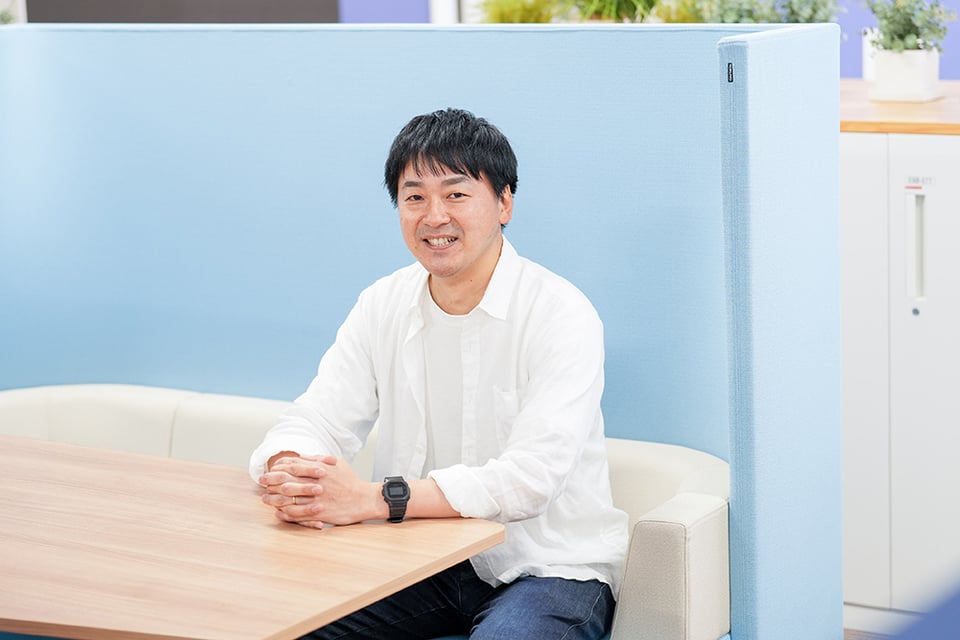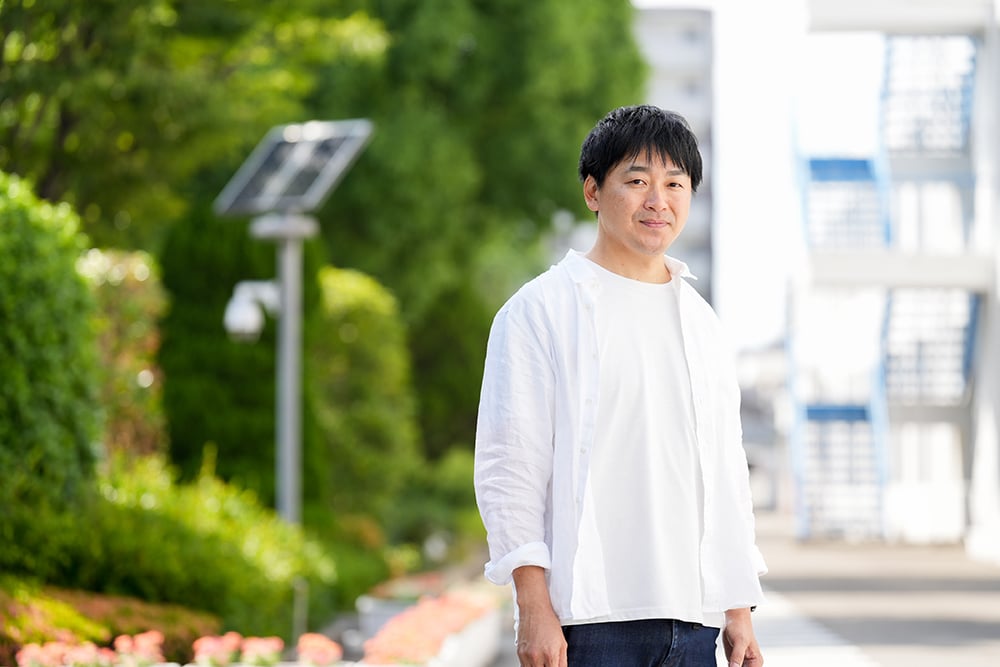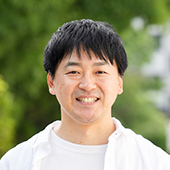Yohei Koyanagi started work for an electronics manufacturer right after graduating from university and has been involved in camera mechanism design for about 12 years. Currently he works in i-PRO’s Corporate Technology Mechanism Practice, where he designs surveillance cameras. What are his thoughts about these cameras—which, while still “cameras” in one sense—require completely different functions? Now that a year has passed since joining the company, he shares his frank thoughts about his work.
The “Camera” Connection That Moved Him to Join i-PRO

You entered your university’s engineering department and went on to graduate school, didn’t you?
Yes, I’ve been interested in manufacturing since I was in high school, and I studied mechanical engineering at university with the intention of working for an automobile company, but by chance I wound up working for an electronics manufacturer.
I switched to i-PRO for several reasons. One was that I come from Saga Prefecture and have to make trips back home to visit my parents. I also thought that this would probably be the only chance for me to change jobs before I turned 40. However, I couldn’t find any companies in Kyushu that could make use of my work experience. Then just in the nick of time a job recruitment offer came in that perfectly matched my needs and experience in camera design, so I made the decision to join i-PRO.
You haven’t lived in Kyushu since you graduated from high school.
At first, I thought there was really nothing here (laughs). But unlike my high school years, when I drove around Kyushu by car, I was surprised to find lots of nice places that I’d never been to before. I was living in Kanagawa Prefecture before, and compared to there, even the neighborhood parks in Kyushu are much more spacious. The scale is different. I have two children, and they are extremely happy here.
What kind of cameras did you work on at your previous company?
At first, I worked on professional-use broadcast cameras for TV stations, the big ones that cameramen hold on their shoulders. After that, I designed consumer-use digital SLR cameras. My specialty was the external and internal structures of the mechanisms.
At i-PRO, I design mechanisms for surveillance cameras. Even though their shapes and sizes are different from the types of cameras I’d worked on before, what the job entails is very similar.
Of course, there are some differences. Take the cameras used by TV stations for example, which are also subject to exacting demands for reliability and robustness. But surveillance cameras must be kept operating 24 hours a day, so in that sense they’re required to have higher reliability than TV cameras. Also, the bodies of surveillance cameras pan from side to side and tilt up and down. I hadn’t worked on these types of mechatronics sections at all, and I realized I needed to learn more about how they operate.
Trusted—the Key to Our Superiority
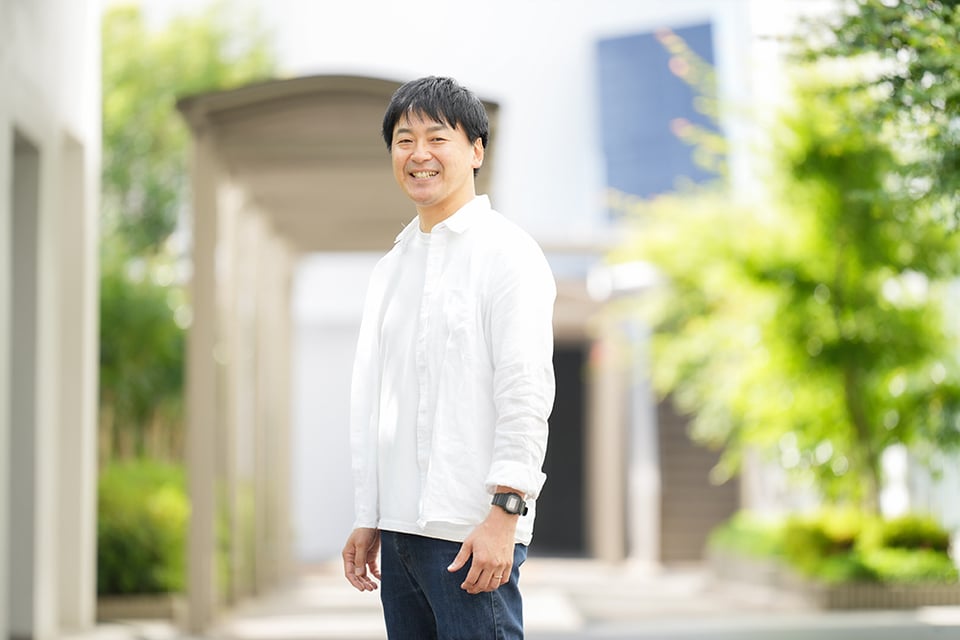
i-PRO has declared its commitment as a manufacturer through advancing the modularization of its production system, but from your point of view, what do you think are i-PRO’s advantages?
Yes, I have been thinking along those lines too. Surveillance cameras are made by many different companies, and they are all competing for the market. The essential thing is how we should differentiate ourselves. For example, we could differentiate by developing some revolutionary technology that would outperform other companies’ products, but that would not correspond to i-PRO’s way of promoting modularization.
Along with reliability and miniaturization, which are the most important aspects of i-PRO mechanisms, I was requested by my superiors after I joined the company to place extra importance on ease of installation. They told me that it’s important for technicians to be able to complete installation jobs quickly, which is certainly true. It’s not easy, but I thought that if we pursued a level of workability that other companies could not match, we would differentiate ourselves in the market.
In fact, we offer a surveillance camera with an auxiliary wire that connects from the ceiling to the main unit, which facilitates installation. This way, the technician’s hands are free to do the work. Our sales staff brings along videos showing how easy it is to install the cameras, which will appeal to customers. Putting these kinds of things together is important.
What project are you currently involved in?
I’m working on a next-generation PTZ (pan, tilt, zoom) camera with a 3.1x zoom. Right now, it’s at the pre-production stage, one step before mass production. It’s almost ready for mass production and is being checked by Quality Assurance. The items really get reviewed in detail. Before proceeding to the review, we will also evaluate the set within the design department to ensure that it is ready to withstand the review process. They go down a list of evaluation programs, and it is like they are trying to see if they can cause failures point by point. For example, when testing water seepage into a camera when it rains, the camera is affixed to a jig and a specific amount of water is squirted at it. Then the camera is disassembled to confirm that no leakage has occurred. In the impact test to check camera robustness, a weighted pendulum strikes against the camera body to ensure it remains undamaged. Testers also program the camera to run the equivalent of hundreds of times over a period of about one month to verify that the wires on the flexible base aren’t damaged. It’s part of the rigorous process of repeated testing, disassembling, and re-testing.
A product must travel down a long road before it’s completed, wouldn’t you say? Do problems sometimes occur after the product has been released on the market?
Market defects should not happen, but they can. Problems can occur when a product is used in unanticipated ways or installed in unforeseen environments. Since such situations are unexpected, our inspection criteria do not necessarily cover such usage or environments.
When a problem does occur, we try to find out why it happened in the first place. We disassemble the product and check the dimensions of each individual part to isolate the problem. In some cases, the design is the problem; in other cases, the parts used may be defective; and in other cases, the cause might have been incorrect assembly. Or it might just be that the dimensions were incorrect at the parts machining stage.
Since our products are intended for B2B, we have to face the customer and explain the cause of a defect as soon as possible. That is why speed is especially called for when analyzing problems.
Viewing the Current Status Positively and Connecting It to Change
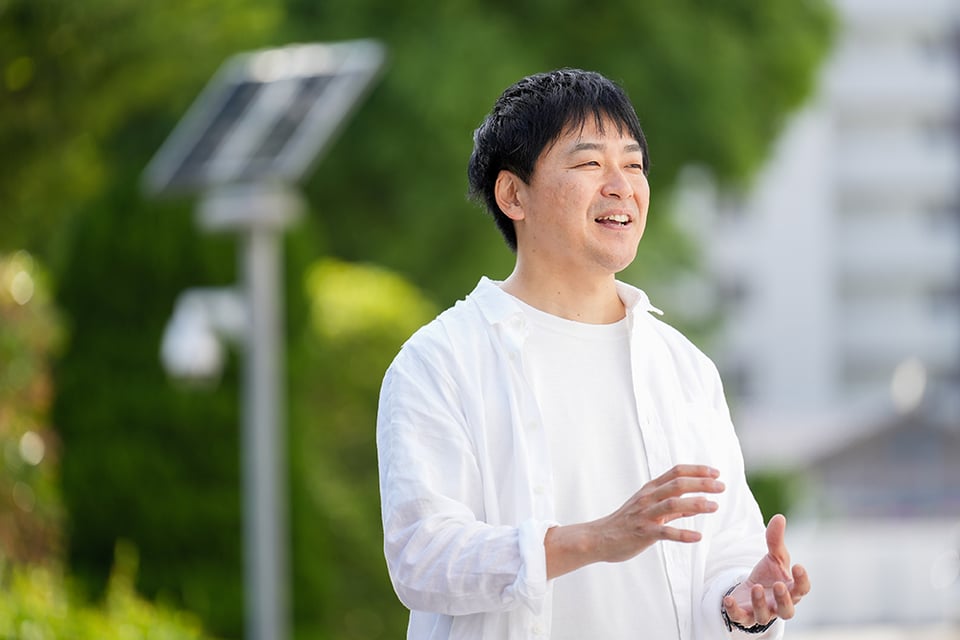
i-PRO is now trying to change in many ways, isn’t it?
As part of our efforts to change the company, we are participating in a project to reduce the lead time for prototypes and speed up the product development cycle. I might offer suggestions such as, “If we adopt this system, an estimate can be prepared in one day—instead of the three days it takes now—and can then proceed with other tasks more efficiently.”
There are several areas for improvement in our work as well, and the PTZ camera project may be unique, but as far as I am concerned, the design process requires a lot of reworking. It would be fine if the design were finished and checked, and it passed the evaluation in one shot, but if failures occur at the evaluation stage, the design has to be redone. I find this repetitive process can be grueling.
I think perhaps this situation could be prevented by checking the design more precisely at the computer-aided design (CAD) stage. After the design is worked out to some extent, the team members check the 3D screen together on CAD terminals. If problems can be identified and corrected at this stage, a design with a high degree of perfection can be created from the get-go. This would reduce repetition and definitely speed up the development process. Currently, the CAD check is the responsibility of a single engineer, which does lead to improving the design’s completeness. That’s something I would like to improve upon.
Do you already know what project you will be working on next?
I’ve heard that we are going to work on the next generation of cameras equipped with IR (infrared) sensors that work at night. My boss has already told me he expects I’ll have a hard time with it. I really want to learn about areas of technology that I haven’t experienced before, and I think this will be a natural way to do this in the future.
I do feel I lack experience in areas apart from technology. I still don’t know what people are looking for in surveillance cameras. I think that if I listen more to customers, I’ll be able to come up with ideas to solve their problems. The truth is, I need to actively go out in the field and get feedback from customers as well. I haven’t had the opportunity to do so yet, but when the PTZ camera I’m working on now is completed, I think I’ll have the chance to hear some customers’ opinions.
It would be really nice to see PTZ cameras out on the streets when they are released. When I am designing, I am pressed for time and it is hard work, but I’ve always loved manufacturing. When the parts arrive and I assemble them into the shape I intended, and the product is released to the world, it gives me a great sense of accomplishment. In the future, I hope to learn new technologies that I haven’t experienced yet and be in charge of mechatronics, which I think will make manufacturing even more fun. Going further, I would like to be able to make proposals like, “How about this kind of product?”

Do you already know what project you will be working on next?
I’ve heard that we are going to work on the next generation of cameras equipped with IR (infrared) sensors that work at night. My boss has already told me he expects I’ll have a hard time with it. I really want to learn about areas of technology that I haven’t experienced before, and I think this will be a natural way to do this in the future.
I do feel I lack experience in areas apart from technology. I still don’t know what people are looking for in surveillance cameras. I think that if I listen more to customers, I’ll be able to come up with ideas to solve their problems. The truth is, I need to actively go out in the field and get feedback from customers as well. I haven’t had the opportunity to do so yet, but when the PTZ camera I’m working on now is completed, I think I’ll have the chance to hear some customers’ opinions.
It would be really nice to see PTZ cameras out on the streets when they are released. When I am designing, I am pressed for time and it is hard work, but I’ve always loved manufacturing. When the parts arrive and I assemble them into the shape I intended, and the product is released to the world, it gives me a great sense of accomplishment. In the future, I hope to learn new technologies that I haven’t experienced yet and be in charge of mechatronics, which I think will make manufacturing even more fun. Going further, I would like to be able to make proposals like, “How about this kind of product?”
It seems that you still have a lot of room to grow as an engineer.
The same is true of i-PRO. When I talk with people in the company about the problems we’re facing, I tell them that the fact that i-PRO is not yet able to do something shows i-PRO’s “room for growth.” That kind of positive thinking is a good thing, isn’t it?
